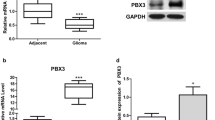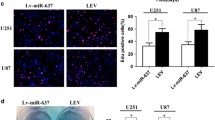Abstract
As the most common brain tumor, glioma is featured with poor prognosis due to its resistance to current therapeutic strategies. The elucidation of etiology is believed to facilitate the development of novel effective anti-glioma treatment modalities. As a confirmed oncogenic microRNA (miRNA) in many other types of cancers, the role of miR-155 in glioma is still unknown. This study is aimed to study the role of miR-155 in the progression of glioma. Our results revealed that miR-155 was overexpressed in the collected glioma specimen, compared with noncancerous brain tissues. The suppression of miR-155 attenuated the proliferation of glioma cells and the activation of Wnt pathway. Silencing miR-155 was also able to suppress the growth of U-87 MG glioma xenografts in mice. Pearson analysis indicated that miR-155 level was inversely correlated with the abundance of HMG-box transcription factor 1 (HBP1), a strong Wnt pathway inhibitor, in glioma samples. Further experiments confirmed that miR-155 suppressed the expression of HBP1 by targeting the putative miRNA recognition elements (MREs) within its messenger RNA (mRNA) 3′ untranslated region (UTR). Furthermore, HBP1 small interfering RNA (siRNA) abolished the effect of miR-155 suppression on the proliferation of glioma and the activation of Wnt pathway. Taken together, miR-155 promoted the progression of glioma by enhancing the activation of Wnt pathway. Thus, targeting miR-155 may be an effective strategy for glioma treatment.






Similar content being viewed by others
References
Goodenberger ML, Jenkins RB. Genetics of adult glioma. Cancer Genet. 2012;205(12):613–21.
Wang Y, Jiang T. Understanding high grade glioma: molecular mechanism, therapy and comprehensive management. Cancer Lett. 2013;331(2):139–46. doi:10.1016/j.canlet.2012.12.024.
Croce CM, Calin GA. miRNAs, cancer, and stem cell division. Cell. 2005;122(1):6–7. doi:10.1016/j.cell.2005.06.036.
Chen Z, Ma T, Huang C, Hu T, Li J. The pivotal role of microRNA-155 in the control of cancer. J Cell Physiol. 2014;229(5):545–50. doi:10.1002/jcp.24492.
Poltronieri P, D’Urso PI, Mezzolla V, D’Urso OF. Potential of anti-cancer therapy based on anti-miR-155 oligonucleotides in glioma and brain tumours. Chem Biol Drug Des. 2013;81(1):79–84. doi:10.1111/cbdd.12002.
Zhang K, Zhang J, Han L, Pu P, Kang C. Wnt/beta-catenin signaling in glioma. J Neuroimmune Pharmacol: Off J Soc NeuroImmune Pharmacol. 2012;7(4):740–9. doi:10.1007/s11481-012-9359-y.
Yan Z, Wang J, Wang C, Jiao Y, Qi W, Che S. miR-96/HBP1/Wnt/beta-catenin regulatory circuitry promotes glioma growth. FEBS Lett. 2014;588(17):3038–46. doi:10.1016/j.febslet.2014.06.017.
Ma L, Liu J, Shen J, Liu L, Wu J, Li W, et al. Expression of miR-122 mediated by adenoviral vector induces apoptosis and cell cycle arrest of cancer cells. Cancer Biol Ther. 2010;9(7):554–61.
Liu J, Ma L, Li C, Zhang Z, Yang G, Zhang W. Tumor-targeting TRAIL expression mediated by miRNA response elements suppressed growth of uveal melanoma cells. Mol Oncol. 2013;7(6):1043–55. doi:10.1016/j.molonc.2013.08.003.
Ma L, Liu J, Liu L, Duan G, Wang Q, Xu Y, et al. Overexpression of the transcription factor MEF2D in hepatocellular cancer sustains malignant character by suppressing G2/M transition genes. Cancer Res. 2014. doi:10.1158/0008-5472.CAN-13-2171.
Wang B, Liu J, Ma LN, **ao HL, Wang YZ, Li Y, et al. Chimeric 5/35 adenovirus-mediated Dickkopf-1 overexpression suppressed tumorigenicity of CD44(+) gastric cancer cells via attenuating Wnt signaling. J Gastroenterol. 2013;48(7):798–808. doi:10.1007/s00535-012-0711-z.
Liu S, Yin F, Zhang J, Wicha MS, Chang AE, Fan W, et al. Regulatory roles of miRNA in the human neural stem cell transformation to glioma stem cells. J Cell Biochem. 2014;115(8):1368–80. doi:10.1002/jcb.24786.
D’Urso PI, D’Urso OF, Storelli C, Mallardo M, Gianfreda CD, Montinaro A, et al. miR-155 is up-regulated in primary and secondary glioblastoma and promotes tumour growth by inhibiting GABA receptors. International journal of oncology. 2012;41(1):228–34. doi:10.3892/ijo.2012.1420.
Ling N, Gu J, Lei Z, Li M, Zhao J, Zhang HT, et al. microRNA-155 regulates cell proliferation and invasion by targeting FOXO3a in glioma. Oncol Rep. 2013;30(5):2111–8. doi:10.3892/or.2013.2685.
Zhou J, Wang W, Gao Z, Peng X, Chen X, Chen W, et al. MicroRNA-155 promotes glioma cell proliferation via the regulation of MXI1. PLoS One. 2013;8(12):e83055. doi:10.1371/journal.pone.0083055.
Meng W, Jiang L, Lu L, Hu H, Yu H, Ding D, et al. Anti-miR-155 oligonucleotide enhances chemosensitivity of U251 cell to taxol by inducing apoptosis. Cell Biol Int. 2012;36(7):653–9. doi:10.1042/CBI20100918.
Lages E, Guttin A, El Atifi M, Ramus C, Ipas H, Dupre I, et al. MicroRNA and target protein patterns reveal physiopathological features of glioma subtypes. PLoS One. 2011;6(5):e20600. doi:10.1371/journal.pone.0020600.
Qiu S, Lin S, Hu D, Feng Y, Tan Y, Peng Y. Interactions of miR-323/miR-326/miR-329 and miR-130a/miR-155/miR-210 as prognostic indicators for clinical outcome of glioblastoma patients. J Transl Med. 2013;11:10. doi:10.1186/1479-5876-11-10.
Sun J, Shi H, Lai N, Liao K, Zhang S, Lu X. Overexpression of microRNA-155 predicts poor prognosis in glioma patients. Med Oncol. 2014;31(4):911. doi:10.1007/s12032-014-0911-x.
**a Z, Wei P, Zhang H, Ding Z, Yang L, Huang Z, et al. AURKA governs self-renewal capacity in glioma-initiating cells via stabilization/activation of beta-catenin/Wnt signaling. Mol Cancer Res: MCR. 2013;11(9):1101–11. doi:10.1158/1541-7786.MCR-13-0044.
Funding
This study was supported by the Research Award Fund for Outstanding Middle-aged and Young Scientists of Shandong Province, China (No. BS2011SW004 and the Scientific Research Fund for Excellent Youth in the Affiliated Hospital of Qingdao University (No. 201506).
Conflicts of interest
None
Author information
Authors and Affiliations
Corresponding author
Rights and permissions
About this article
Cite this article
Yan, Z., Che, S., Wang, J. et al. miR-155 contributes to the progression of glioma by enhancing Wnt/β-catenin pathway. Tumor Biol. 36, 5323–5331 (2015). https://doi.org/10.1007/s13277-015-3193-9
Received:
Accepted:
Published:
Issue Date:
DOI: https://doi.org/10.1007/s13277-015-3193-9




